traditional decorating...
- The Heritage Information Trust
- The Guild of Master Craftsmen
- Approved Lincrusta Installers and Restorers
- Traditional Techniques
- The History of Period Styles in Britain
- Preserving our Rich and Varied History
the heritage information trust...

The Heritage Information Trust since 2003 has sanctioned the high class decorating service offered by G B Decorating in this specialised field. This status was not appointed, until a rigorous and lengthy vetting procedure was entered into, which upon satisfactory completion to the Trusts liking, acknowledges the understanding required to perform this delicate and prestigious work. The Trust is supported by English Heritage, The National Trust, and The Crown Estate, Council for the Care of Churches and The Department of Trade and Industry.
the guild of master craftsmen...
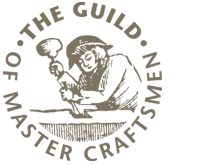
After further rigorous vetting by The Guild of Master Craftsmen, G B Decorating was invited to its membership, an organization devoted to the promotion of excellence and the engendering of craftsmanship.
After a period of mutual beneficial membership, we have now parted company
lincrusta installers and restorers...

To view our status as approved Advanced Lincrusta Installers and Restorers and the latest available patterns enter Yorkshire into the Select A County option here.
traditional techniques...
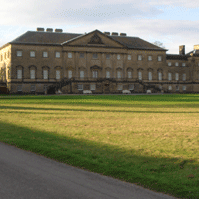


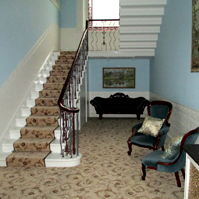
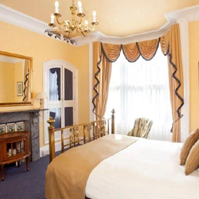
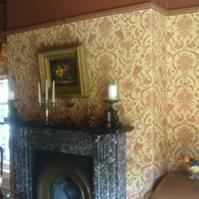
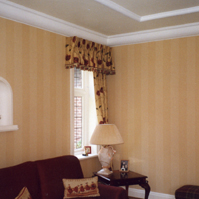
Traditional decorating incorporates materials appropriate to the time, along with some specialist finishing styles and crafts, uncommon to the modern decorator. These tried and tested materials not only compliment the buildings fabric, thus helping the building to breathe, and due to their composite natural ingredients have vast environmental, sustainable advantages. Typical period materials are lime, linseed oil, casein and mineral pigments to name a few.
The understanding of a buildings fabric is paramount to ensuring the longevity of any one type of building. This is plain to see when modern plastic wall coatings have been applied to backfilled cavity / strawbale / clay or cob walls, therefore reducing significantly the permeability of the outer surface. This in turn, results in the fabric of the wall sweating, as it is unable to expel moisture, the outcome of which, the wall becomes saturated and begins to decay from within, over a length of time.
With over a third of the United Kingdoms housing being of period stock (Tudor, Georgian, Victorian, Edwardian and Arts Décor eras), and with the popularity of magazines such as 'Period Ideas', and the currently popular TV Programmes like 'Grand Designs', this will be of great interest to homeowners, country estates, museums, hotels, restaurants, public inns, building contractors, architects and interior designers alike.
Traditional techniques and materials are regularly employed during the restoration and re-decoration of prestigious historical and listed buildings, capturing their timeless designs. Having experienced an interesting and varied workload to date, undertaking the pleasure of having worked at the museums of Temple Newsam and Nostell Priory, the listed West Riding Public inn, along with contracts in and around the county of Yorkshire and the capital, London. By the use of such materials and craftsmanship, G B Decorating endeavour to preserve and recreate timeless finishes and designs of days gone by while reducing the irreversible damage to these fine buildings, thus helping to maintain the diverse and colourful architectural heritage of this land.
As Louise Ward so charmingly describes the ideal country house, (Waugh's Brideshead); "a palimpsest with every generation leaving their mark but never removing the evidence of what was before" and so it is with paint layers.

the history of period styles in Britain...
Tudor (1485-1603)
During this period England emerged from the medieval world having two of the strongest monarchs to ever sit on the throne, Henry VIII and his daughter Elizabeth I, which brought about a period of stability and peace but notably the end of the Catholic Church in England.
Tudor England was predominantly a farming society with 90% of the population living in small villages making their living from the land, with the remainder living in big Tudor cities such as London, Bristol and Norwich. The mining of coal, tin and lead became popular and with it wealthy Tudors, who loved to exhibit their riches and place in society with elegant cloths and the homes they lived in being palaces or mansions.
Tudor houses were framed with massive upright vertical timbers which were usually oak and occasionally elm, these were often supported by diagonal timbers. These timbers were blackened and created a skeleton which was filled with brick, plaster or most commonly wattle and daub. Bricks and glass being a new innovation were expensive and therefore the reserve of the rich, but in 1467 a regulation demanded the use of brick or stone in the building of chimneys to prevent the spread of fire. Houses of the poor therefore consisted of wattle and daub, with mortar and then white-wash was applied. This process resulted in the highly distinctive black and white half-timber Tudor houses we associate with today.
Georgian (1714-1837)
At the beginning of the Georgian era the work of Italian architect Andrea Palladio (1508-1580) was extremely influential. Palladian style recreated the classic style of Rome with principles of symmetry, proportion and order.
In the second half of the 18th century the work of Robert Adam took the classical style to new heights of refinement and elegance. This Neo-Classical style was influenced by the Renaissance and tended to move away from the more solid nature of the previous Georgina period towards something more delicate and visually lighter.
Georgian decoration exuded elegance and style. In grand aristocratic homes the aim was to re create the splendour of ancient Rome and the Renaissance by means of elaborate plasterwork, pillared entrances, deep cornices and skirtings. Ceilings would be divided into symmetrical segments around a central motif or ceiling rose and painted in intricate colour schemes. Walls would be divided horizontally into three parts to represent the classical proportions of the column.
In town houses the walls would be totally panelled from floor to ceiling without any ornate use of plasterwork and painted a single colour. A darker shade may have been used to emphasise details such as skirting boards and doors.
The Regency period (1800-1830) was inspired by a succession of revivals of the earlier English styles, reflected in the introduction of stronger, but still relatively subdued colours used in contrast to conventional creams and putties.
Victorian (1837-1901)
During the Victorian era imports from the colonies and the mass production of goods enabled by the Industrial Revolution meant that the middle classes could decorate and furnish their homes in a much more lavish style. For inspiration the Victorians plundered the past, reviving styles such as Gothic, French Rococo and Italian Renaissance. This period is typified by a richness of colour, decoration and opulence.
The early Victorian Gothic Revival style (1830s and 1840s) was led by the work of A.W. Pugin, who was inspired by the work of the craftsmen of the Middle Ages.
In the latter half of the period, William Morris founded the Arts and Crafts movement which renounced mass production and standardisation and insisted on a return to handcrafted items made from high quality materials.
Everything was very ornate and intensely decorated in this period. Three part colour schemes were popular, which split the wall into floor to dado rail, dado rail to picture rail and picture rail to ceiling. In the early Victorian era walls were usually painted in relatively light colours. The Gothic era favoured richer and darker colours in keeping with its medieval inspiration, complemented by use of dark wooden panelling.
The latter half of the period gave way to more opulent and exotic colour schemes that reflected the influence of the Empire. Large ceiling roses and other ornate mouldings, that were painted in multi-coloured combinations or gilded, added to the overall richness of the look.
The Arts and Crafts period returned to forms and colours that were inspired by nature and the natural world, such as floral motifs and foliage.
Edwardian & Art Deco (1901-1939)
The Edwardian era was influenced by diverse styles over a short period of time. Initially there was a return to classical elegance and simplicity. Art Nouveau, regarded as the first modern style of this era, sought its initial inspiration in the natural world, embracing plant forms and organic lines.
Art Deco (1920s and 1930s) emerged from the bleakness of the First World War to provide a fresh new look that was more angular and streamlined, yet lavish and unashamedly contemporary. Initially Art Deco embraced simple and abstract motifs in elegant and exotic forms, this abstraction being well illustrated in work and particularly the furniture of Charles Rennie Mackintosh. At its peak the inspiring Exposition Internationale des Arts Decoratifs et Industriels held in Paris in 1925 conveyed the image of elegant luxury popular to the time.
Edwardian walls tended to feature muted but lighter colours derived from nature such as yellows, greens and blues. Dado rails disappeared, leaving only the picture rail, and walls were decorated in uniform colours with contrasting woodwork painted in either a very dark or very light shade. Ceilings were painted in off-white and had relatively simple mouldings.
Art Deco retained some of this neutrality but also experimented with brighter shades such as pinks, turquoises, aquas and blues, many of the colours inspired by shades favoured in fashionable grand hotels of the time. In sitting, dining and bedrooms, Edwardian floors were of stained and varnished parquet, covered with rugs. In other areas such as the kitchen, hall, bathroom and porch, heavily patterned tiles arranged in panels and interspersed with white tiles to accentuate the detail are more authentic.
Classic Whites (mid 20th - present)
There is no doubt that architectural style and interior design changed dramatically over the Georgian, Victorian and Edwardian eras. Stylistic evolution over more than two centuries displays a marked change in fashion and taste, but there was always one common denominator: the use of white.
Whether acting as a foil for richer colours, lightening a darker area, or even highlighting a particular feature in a room, the range of whites gave an extra and much valued dimension to the palette of every era.
Whatever the collection of colours in vogue at the time, there was always the need for a range of whites. Examples are readily found within the periods: the buildings of the Palladio adhere to this palette of stone and off-whites to put over a look of classical refinement and it was towards the beginning of the 20th Century that Charles Rennie Mackintosh experimented with completely white colour schemes, bringing forth the age of the whites palette in its own right. This had a second heyday in the futuristic minimalism of the 1960's.
Today, at the beginning of the 21st Century, this neutral look still gives a completely contemporary feel to an interior, providing a canvas for all furniture and fittings, no matter which era they originally came from.
preserving our rich & varied history...
History at Home
Everyone's house has a history, this can often be found on the walls and ceilings of each room. Accumulated layers of paint can leave a unique record of the styles and fashions that have influenced them over the years. Skilled architectural paint researchers are able to interpret the story of a house from a detailed analysis of paint samples alongside a structural analysis of the building. This will give you information that may allow you to recreate one of the original colour schemes.
Alternatively you may wish to go for a more contemporary look, or colours that reflect your individual tastes. Whichever scheme you decide on, it is always useful to leave evidence of what was done in the past, whether this is leaving layers of paint, or traces of old wall coverings. If your house is of particular historic interest, it maybe desirable to conserve old finishes or decorative schemes by persevering them under modern lining paper. If you are in any doubt, your local Conservation Office would be able to give you advice on how best you might protect these pieces of historical evidence for the future.
Unless your house is a Grade I or II* listed building, changing the interior colour scheme is unlikely to require consent. However, if you do live in such a building or conservation area, it would be advisable to consult a Conservation Officer before making major changes to exterior colours or introducing new finishes.





